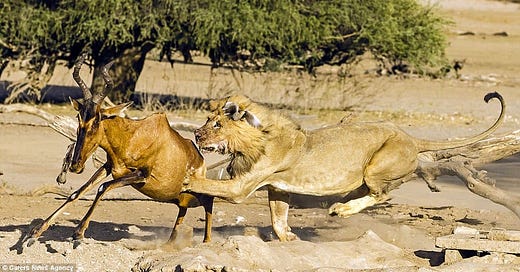Following up some of my earlier posts on the nature of PTSD and how many different causal agents illicit similar symptomatic responses, here is an example of how different combat experiences involve completely different portions of our brains because of our evolved nature.
1. The Threat Eminence Continuum in Prey Animals
The "threat eminence continuum" is the idea that an animal's behavior and brain activity shift depending on how imminent a threat is. It's not a binary "safe or unsafe" — it's a spectrum.
Low Threat: Animal is alert but calm — scanning the environment, grazing, mild vigilance.
Medium Threat: Animal notices potential danger — freezes, or becomes hypervigilant, preparing to flee.
High Threat (Imminent): Predator detected — intense sympathetic activation (freeze, flight, or fight response), explosive escape, panic behaviors.
Neural Activity in Prey:
Low threat: Hippocampus (spatial memory/navigation) and medial prefrontal cortex are active — rational monitoring.
Medium threat: Amygdala (fear processing) becomes more engaged — assessing risks.
High threat: Periaqueductal gray (PAG) in the midbrain takes over — primal defensive behaviors (freeze, run, fight).
2. Example: Elk Grazing
Low threat: An elk in an open meadow, casually grazing. Hippocampus mapping surroundings, mild amygdala activity scanning for threats.
Medium threat: Catches scent of wolves — ears perk up, body stiffens, stops eating. Amygdala ramps up, prefrontal cortex evaluates: flee or freeze?
High threat: Wolves appear — no thinking, just burst of adrenaline, massive activation of PAG, elk flees at full speed.
3. Example: A Raccoon in Your Shed
Low threat: Raccoon casually rummaging, prefrontal cortex is dominant — planning, foraging, exploring.
Medium threat: Hears you approach — freezes, heightened amygdala activity, assessing your movements.
High threat: You open the door — raccoon freezes, bolts or hisses defensively, PAG-driven instinctive behavior kicks in.
4. Predator Behavior: Lion Hunting
Now, predators are wired differently.
Low threat: Lion at rest — hippocampus and prefrontal cortex engaged, little amygdala activity.
Hunting phase: High focus but low fear — prefrontal cortex and motor planning areas are dominant.
Neural Difference: Predators suppress their own fear responses when stalking. They need precision, patience, and planning, not panic.
Final Attack: Burst of motor cortex and limbic system (reward circuits), still with tight inhibitory control to maximize efficiency.
Contrast: Prey ramps into panic as threat increases. Predators suppress panic to maintain tactical focus.
5. Human Parallel: Soldiers in War
Soldiers experience this continuum exactly — war puts humans into prey and predator modes depending on the situation.
Being Ambushed (Prey Mode):
Low to High threat in seconds.
Initial confusion, amygdala surges, PAG activates.
Responses: dive for cover, instant reflexes, tunnel vision, massive sympathetic nervous system activation (adrenaline dump).
Brain: Fast switch from prefrontal dominance to limbic system control (survival instincts).
Analogous to elk detecting wolves.
Conducting a Raid (Predator Mode):
Planned offensive movement.
Prefrontal cortex dominant — planning, coordination, inhibition of fear.
Amygdala is engaged but managed — soldiers have to stay sharp, but not panic.
Final breach (entry): Controlled aggression, precision, with reward system activation (goal accomplishment).
Analogous to lion stalking prey.
6. Final Synthesis
Prey animals react to threat along a continuum from vigilance to panic.
Predators suppress fear to maintain focus on executing a goal.
Humans can toggle between these modes based on training and context: in war, soldiers are sometimes prey (ambushed) and sometimes predators (raiding).
The brain’s wiring is ancient — it toggles between these modes largely based on threat perception and immediacy, with different brain regions dominating.


